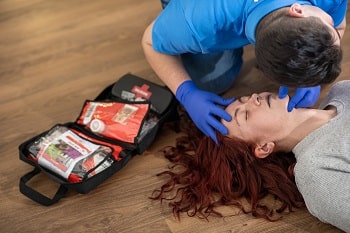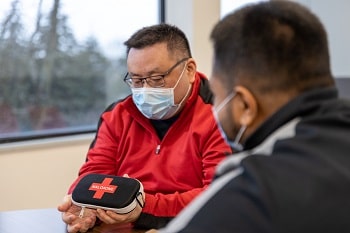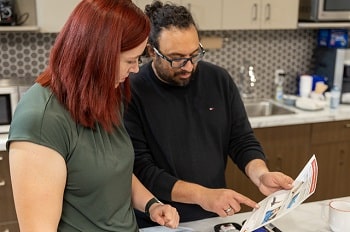 |
| Credit: Drew Hayes / Unsplash |
Between January 2016 and September 2021 alone, the Public Health Agency of Canada reported a total of 26,690 apparent opioid-related deaths - the vast majority being accidental. Tragically, this situation has only worsened during the COVID-19 pandemic.
Opioid poisoning can happen any time and to anyone: a loved one, friend, colleague or neighbour. If you found someone in need of help, would you know what to do to help?
We asked Canadian Red Cross Prevention and Safety Coordinator Jeannene Crosby and Opioid Harm Reduction Advisory Council volunteer Jessica Farmer to break down how to recognize and respond to a suspected opioid poisoning.
What are opioids and why can they be deadly?
Opioids are medications prescribed by a doctor to help relieve pain during recovery from an injury or in treatments for chronic illness. It is also used during surgery, when a person is under anesthesia.
“The first experience a person may have with an opioid might be through medical prescription,” Jessica says. “Under the close attention of a physician, opioids can be given safely, however there is a risk that this use could easily spiral into a long-term substance disorder.”
Jeannene notes, “Currently, we’re seeing an increase in the use of both prescription and non-prescription opioids across Canada, combined with an illegal opioid supply of inconsistent quality and strength, often containing fentanyl and carfentanyl, which are significantly stronger than heroin.”
“Opioid poisoning is a medical emergency. Immediate response is needed to save a person’s life,” she adds. “If untreated, opioid poisoning will eventually cause respiratory and cardiac arrest, leading to death. This is why it’s so important for people to know how to spot the signs of opioid poisoning and help the person who is in distress, without hesitation or judgment.”
 Jessica personally experienced an opioid-related tragedy when her 23-year-old nephew, Dylan, died from an unintentional carfentanil poisoning in 2017. Since this family loss, she has fully committed herself to bringing public awareness and education about opioids, opioid poisoning and substance use disorder. She believes it’s important to be aware of how to help someone in opioid-related distress.
Jessica personally experienced an opioid-related tragedy when her 23-year-old nephew, Dylan, died from an unintentional carfentanil poisoning in 2017. Since this family loss, she has fully committed herself to bringing public awareness and education about opioids, opioid poisoning and substance use disorder. She believes it’s important to be aware of how to help someone in opioid-related distress.“A bystander could be the person who makes the difference between life, permanent brain damage, or death. By saving someone from an opioid poisoning, you’re keeping them alive and giving them an opportunity to get the help they need to recover from substance use disorder. In our communities, every life should matter. Everyone is important to someone, and you could be the one to save a life.”
Opioid Harm Reduction: A Red Cross priority
“Opioid poisoning and its often-tragic consequences have rapidly become one of Canada’s most pressing health issues. The Canadian Red Cross is proud to bring our strength and resources to respond to this serious challenge,” explains Jeannene.
 “We’re currently developing a program to reduce opioid-related death through opioid poisoning response training and increasing access to naloxone – a life-saving medication that temporarily reverses the effects of opioids.”
“We’re currently developing a program to reduce opioid-related death through opioid poisoning response training and increasing access to naloxone – a life-saving medication that temporarily reverses the effects of opioids.”Through this program, the Red Cross expects to deliver this specific response training to about 1.5 million Canadians, while helping millions more gain an increased understanding of the risks, stigmas, and misconceptions of opioid use.
“Our program will focus on reaching people at risk for opioid poisoning in under-served, remote and rural communities in all provinces and territories, except Quebec, where a similar program is already in place,” says Jeannene.
How to recognize signs of opioid poisoning
Jeannene explains some of the clearest signs and symptoms of opioid poisoning:- slowed breathing (or no breathing)
- choking or snoring sounds
- chest tightness
- extreme drowsiness or unresponsiveness
- pale or blue/grey skin or lips
- small pupils (the black parts of the eyes)
How to respond to a possible opioid poisoning
If you see a person in distress and suspect opioid poisoning, take the following steps:
1. Get help by calling 9-1-1 or your local emergency number, and get an AED and a naloxone kit if available. Naloxone is commonly available as either an easy-to-use nasal spray or an injection. It reverses the effects of opioid poisoning until the person can receive professional medical care.
2. Check the person and proceed based on what you see. Naloxone can cause rapid changes in the person’s condition, so re-check them often. More naloxone may be needed. Don’t worry, you will not hurt a person by giving them naloxone, even if they are not actually suffering from opioid poisoning, and naloxone can easily save someone’s life. You can give it to any person who might need it, even if they are not able to ask for your help.
3. If the person is unresponsive and NOT breathing normally, start CPR. Once naloxone is ready, pause CPR briefly to give the naloxone, then continue CPR until emergency personnel arrive.
4. If the person is unresponsive, but breathing normally, give naloxone and monitor them closely until emergency personnel arrive. Naloxone should be provided to any person who is not breathing normally or who is unresponsive if you suspect opioid poisoning.
Here’s how to give nasal naloxone:
- Open your naloxone kit and remove the nasal spray device from the packaging
- Place your thumb on the plunger and hold the nasal spray tip between your middle and index fingers
- Gently tilt the person’s head back slightly and support it in this position
- Insert the tip of the device into one of the person’s nostrils until your fingers touch the bottom of their nose
- Give the entire dose of medication by pressing firmly on the plunger, then immediately remove the device from the person’s nostril.
Find first aid training and resources in your community
 The Canadian Red Cross has a goal that no one in Canada will experience an opioid poisoning without someone being there who has a naloxone kit and knows how to use it.
The Canadian Red Cross has a goal that no one in Canada will experience an opioid poisoning without someone being there who has a naloxone kit and knows how to use it.To help save lives, the Red Cross Opioid Harm Reduction project is designed to increase awareness, training, and access to naloxone to reduce the devasting impacts of opioid poisoning.
Anyone 13 years of age and older can make a difference in their community by taking the Red Cross’ Becoming an Opioid Harm Reduction Champion course. Through this training, they’ll learn how to respond to an opioid poisoning, build life-saving skills, access resources, help raise awareness, and end social stigma.
“It’s a good idea to check you community for additional resources. Naloxone kits are easy-to-use and available in many communities across the country,” Jeannene recommends. “Depending on where you live in Canada, naloxone kits are available at pharmacies, typically free of charge. They may also be available through organizations like social services, public health units, registered nurse or pharmacist associations. You can pick one up to have on hand in case you encounter an opioid-related first aid emergency.”
Jessica agrees and emphasizes the importance of having naloxone kits readily available to the public: “These kits will not only save lives, but also send a message to people struggling with substance use disorder that others in their community care about them, and are able to help them in an emergency,” she says.
The Canadian Red Cross is committed to helping communities reduce opioid-related deaths and helping Canadians better understand the risks, stigmas, and misconceptions, of opioid poisoning. Find helpful resources on opioid poisoning awareness, education and training here.
This initiative was funded by a contribution from Health Canada’s Substance Use and Addictions Program (SUAP). The views expressed herein do not necessarily represent the views of Health Canada.
Related stories:

